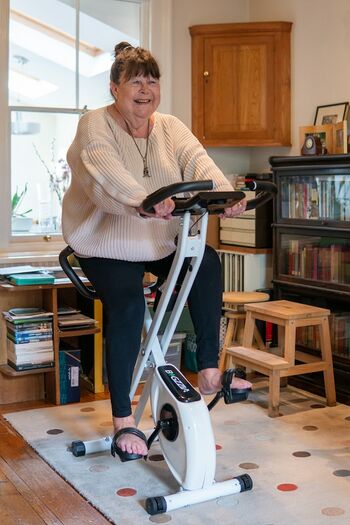High Intensity Interval Training
Original Editor - Sehriban Ozmen
Top Contributors - Sehriban Ozmen
Description[edit | edit source]
High-intensity interval training (HIIT), is a type of exercise in which high-intensity exercises are performed with periods of low-intensity exercise or rest. [1]
HIIT, which has different subcategories, is generally divided into low or high-volume HIIT, depending on whether the time spent in active intervals is under or over 15 minutes. [1]
Evidence-Based Effects[edit | edit source]
In a review study [1], it has been found that HIIT programs are effective in improving:
- VO2max [2], endurance capacity [3][4],
- Substrate metabolism [5],
- Body composition [6],
- Insulin sensitivity [7][8],
- Cognitive functions [9][10] [11].
Also, HIIT has been shown to decrease the risk for: [1]
- Cardiovascular diseases [12][13],
- Breast cancer [14],
- Metabolic syndrome [15],
- Osteoarthritis [16][17],
- Rheumatoid arthritis known to cause lower back pain [18][19][20][21].
Clinical Populations[edit | edit source]
Significant evidence is growing regarding the use of HIIT in chronic diseases. [22]
Cardiovascular disease is the most studied among them. Improved peak oxygen consumption (VO2peak), [23][24] functional capacity and quality of life [22] are the demonstrated benefits of HIIT in patients with cardiovascular disease. In a recent randomised control study [25], it has been proven that six months of supervised high-intensity interval training following percutaneous coronary intervention reduced atheroma volume in residual coronary atheromatous plaques.
Pulmonary disease and Type 2 Diabetes (T2D) are chronic diseases studied less. In patients with pulmonary disease, HIIT is shown to be effective in improving functional capacity, quality of life, and symptoms like dyspnea and leg discomfort. For patients with T2D, HIIT was shown to be effective in positively altering the percentage of body fat and increasing peak power output. [22]
In different studies positive effects of HIIT such as enhancing functional recovery, [26][27][28] cardiorespiratory fitness (CRF), [26][28] and gait parameters [26] [29][30][27] [28] are shown in patients who had a stroke. However, further study establishing the feasibility, safety, and efficacy is needed to guide clinical practice in post-stroke rehabilitation. [31]
Prescription[edit | edit source]
According to a guideline [32] for the delivery and monitoring of HIIT in clinical populations:
| Step 1: Measure (by maximal exercise testing) or estimate (by prediction equations) maximal heart rate (HRmax). | Step 2: Calculate the HR target zone (equates to 85– 95% HR max). |
| Step 3: Validate the HR target zone using a Rating of Perceived Exertion (RPE). For this process, start the first high-intensity interval at RPE 15 and finish at RPE 17–18 within 4 min. For each of the next three intervals, try to reach RPE 17-18 by the halfway point at 2 min. | Step 4: Validate the HR target zone according to the highest HR recorded for each interval at step 3. (Step 4a). If HR does not remain within the HR target zone, calibration of the HR target zone (Step 4b) can be made with one of these options: repeating the maximal exercise test or estimating a new HR max and recalculating the HR target zone. |
Clinical Considerations[edit | edit source]
Indications For Ceasing HIIT[edit | edit source]
- Oxygen saturation < 88%
- Rise in blood pressure > 220/105mmHg
- Drop in systolic blood pressure >10mmHg from baseline during high-intensity interval
- Slowing heart rate with higher workload or development of any atypical arrhythmia. [33]
Absolute Contraindications[edit | edit source]
- Obstructive left main artery disease
- Unstable angina
- Uncontrolled cardiac arrhythmia
- Acute endocarditis, myocarditis, or pericarditis
- Moderate to severe aortic stenosis
- Decompensated heart failure
- Acute pulmonary embolism, or deep vein thrombosis
- Aortic dissection
- Higher degree heart block
- Hypertrophic obstructive cardiomyopathy
- Recent stroke or transient ischemic attack
- Uncontrolled diabetes
- Retinopathy
- Severe autonomic or peripheral neuropathy
- Acute systemic illness or fever
- Acute or chronic renal failure
- Pulmonary fibrosis or interstitial disease
- Recent myocardial infarction (<4 weeks), coronary artery bypass surgery (<4 weeks), or percutaneous intervention (<3 weeks). [33][34]
Resources[edit | edit source]
From the American College of Sports Medicine (ACSM):
- High-Intensity Interval Training | Downloadable Brochure
- The 7-Minute Workout | Infographic
- Interval Training for Cardiometabolic and Brain Health | Infographic and Visual Abstract
- Monitoring Aerobic Exercise Intensity | Infographic
References[edit | edit source]
- ↑ 1.0 1.1 1.2 1.3 Atakan MM, Li Y, Koşar ŞN, Turnagöl HH, Yan X. Evidence-based effects of high-intensity interval training on exercise capacity and health: A review with historical perspective. International journal of environmental research and public health. 2021 Jul 5;18(13):7201.
- ↑ Batacan RB, Duncan MJ, Dalbo VJ, Tucker PS, Fenning AS. Effects of high-intensity interval training on cardiometabolic health: a systematic review and meta-analysis of intervention studies. British journal of sports medicine. 2017 Mar 1;51(6):494-503.
- ↑ Atakan MM, Güzel Y, Bulut S, Koşar ŞN, McConell GK, Turnagöl HH. Six high-intensity interval training sessions over 5 days increases maximal oxygen uptake, endurance capacity, and sub-maximal exercise fat oxidation as much as 6 high-intensity interval training sessions over 2 weeks. Journal of sport and health science. 2021 Jul 1;10(4):478-87.
- ↑ Rosenblat MA, Perrotta AS, Thomas SG. Effect of high-intensity interval training versus sprint interval training on time-trial performance: a systematic review and meta-analysis. Sports Medicine. 2020 Jun;50:1145-61.
- ↑ Talanian JL, Galloway SD, Heigenhauser GJ, Bonen A, Spriet LL. Two weeks of high-intensity aerobic interval training increases the capacity for fat oxidation during exercise in women. Journal of applied physiology. 2007 Apr 1.
- ↑ Sultana RN, Sabag A, Keating SE, Johnson NA. The effect of low-volume high-intensity interval training on body composition and cardiorespiratory fitness: a systematic review and meta-analysis. Sports Medicine. 2019 Nov;49:1687-721.
- ↑ Jelleyman, C.; Yates, T.; O’Donovan, G.; Gray, L.J.; King, J.A.; Khunti, K.; Davies, M.J. The effects of high-intensity interval training on glucose regulation and insulin resistance: A meta-analysis. Obes. Rev. 2015, 16, 942–961. [CrossRef]
- ↑ Babraj JA, Vollaard NB, Keast C, Guppy FM, Cottrell G, Timmons JA. Extremely short duration high intensity interval training substantially improves insulin action in young healthy males. BMC endocrine disorders. 2009 Dec;9(1):1-8.
- ↑ Drigny J, Gremeaux V, Dupuy O, Gayda M, Bherer L, Juneau M, Nigam A. Effect of interval training on cognitive functioning and cerebral oxygenation in obese patients: a pilot study. Journal of rehabilitation medicine. 2014 Nov 1;46(10):1050-4.
- ↑ Hsieh SS, Chueh TY, Huang CJ, Kao SC, Hillman CH, Chang YK, Hung TM. Systematic review of the acute and chronic effects of high-intensity interval training on executive function across the lifespan. Journal of Sports Sciences. 2021 Jan 2;39(1):10-22.
- ↑ Mekari, S.; Neyedli, H.F.; Fraser, S.; O’Brien, M.W.; Martins, R.; Evans, K.; Earle, M.; Aucoin, R.; Chiekwe, J.; Hollohan, Q.; et al. High-Intensity Interval Training Improves Cognitive Flexibility in Older Adults. Brain Sci. 2020, 10, 796. [CrossRef]
- ↑ Cassidy S, Thoma C, Houghton D, Trenell MI. High-intensity interval training: a review of its impact on glucose control and cardiometabolic health. Diabetologia. 2017 Jan;60(1):7-23.
- ↑ Weston KS, Wisløff U, Coombes JS. High-intensity interval training in patients with lifestyle-induced cardiometabolic disease: a systematic review and meta-analysis. British journal of sports medicine. 2014 Aug 1;48(16):1227-34.
- ↑ Mijwel S, Jervaeus A, Bolam KA, Norrbom J, Bergh J, Rundqvist H, Wengström Y. High-intensity exercise during chemotherapy induces beneficial effects 12 months into breast cancer survivorship. Journal of Cancer Survivorship. 2019 Apr 15;13:244-56.
- ↑ Dun Y, Thomas RJ, Smith JR, Medina-Inojosa JR, Squires RW, Bonikowske AR, Huang H, Liu S, Olson TP. High-intensity interval training improves metabolic syndrome and body composition in outpatient cardiac rehabilitation patients with myocardial infarction. Cardiovascular diabetology. 2019 Dec;18(1):1-1.
- ↑ Keogh, J.W.L.; Grigg, J.; Vertullo, C.J. Is Home-Based, High-Intensity Interval Training Cycling Feasible and Safe for Patients With Knee Osteoarthritis?: Study Protocol for a Randomized Pilot Study. Orthop. J. Sports Med. 2017, 5, 2325967117694334. [CrossRef]
- ↑ Smith-Ryan, A.E.; Blue, M.N.M.; Anderson, K.C.; Hirsch, K.R.; Allen, K.D.; Huebner, J.L.; Muehlbauer, M.J.; Ilkayeva, O.R.; Kraus, V.B.; Kraus, W.E.; et al. Metabolic and physiological effects of high intensity interval training in patients with knee osteoarthritis: A pilot and feasibility study. Osteoarthr. Cartil. Open 2020, 2, 100083. [CrossRef]
- ↑ Verbrugghe J, Agten A, Stevens S, Hansen D, Demoulin C, Eijnde BO, Vandenabeele F, Timmermans A. High intensity training to treat chronic nonspecific low back pain: Effectiveness of various exercise modes. Journal of Clinical Medicine. 2020 Jul 27;9(8):2401.
- ↑ Helmhout PH, Harts CC, Staal JB, Candel MJ, De Bie RA. Comparison of a high-intensity and a low-intensity lumbar extensor training program as minimal intervention treatment in low back pain: a randomized trial. European spine journal. 2004 Oct;13:537-47.
- ↑ da Cruz Fernandes IM, Pinto RZ, Ferreira P, Lira FS. Low back pain, obesity, and inflammatory markers: exercise as potential treatment. Journal of Exercise Rehabilitation.2018 Apr;14(2):168.
- ↑ Bartlett DB, Willis LH, Slentz CA, Hoselton A, Kelly L, Huebner JL, Kraus VB, Moss J, Muehlbauer MJ, Spielmann G, Kraus WE. Ten weeks of high-intensity interval walk training is associated with reduced disease activity and improved innate immune function in older adults with rheumatoid arthritis: a pilot study. Arthritis research & therapy. 2018 Dec;20:1-5.
- ↑ 22.0 22.1 22.2 Ross LM, Porter RR, Durstine JL. High-intensity interval training (HIIT) for patients with chronic diseases. Journal of sport and health science. 2016 Jun 1;5(2):139-44.
- ↑ Guiraud T, Nigam A, Gremeaux V, Meyer P, Juneau M, Bosquet L. High-intensity interval training in cardiac rehabilitation. Sports medicine. 2012 Jul;42:587-605.
- ↑ Cornish AK, Broadbent S, Cheema BS. Interval training for patients with coronary artery disease: a systematic review. European journal of applied physiology. 2011 Apr;111:579-89.
- ↑ Vesterbekkmo EK, Aksetøy IL, Follestad T, Nilsen HO, Hegbom K, Wisløff U, Wiseth R, Madssen E. High-intensity interval training induces beneficial effects on coronary atheromatous plaques: a randomized trial. European Journal of Preventive Cardiology. 2023 Apr 1;30(5):384-92.
- ↑ 26.0 26.1 26.2 Boyne P, Dunning K, Carl D, Gerson M, Khoury J, Rockwell B, Keeton G, Westover J, Williams A, McCarthy M, Kissela B. High-intensity interval training and moderate-intensity continuous training in ambulatory chronic stroke: feasibility study. Physical therapy. 2016 Oct 1;96(10):1533-44.
- ↑ 27.0 27.1 Askim T, Dahl AE, Aamot IL, Hokstad A, Helbostad J, Indredavik B. High‐intensity aerobic interval training for patients 3–9 months after stroke. A feasibility study. Physiotherapy research international. 2014 Sep;19(3):129-39.
- ↑ 28.0 28.1 28.2 Ivar Gjellesvik T, Brurok B, Hoff J, Tørhaug T, Helgerud J. Effect of high aerobic intensity interval treadmill walking in people with chronic stroke: a pilot study with one year follow-up. Topics in stroke rehabilitation. 2012 Jul 1;19(4):353-60.
- ↑ Lau KW, Mak MK. Speed-dependent treadmill training is effective to improve gait and balance performance in patients with sub-acute stroke. Journal of rehabilitation medicine. 2011 Jul 1;43(8):709-13.
- ↑ Pohl M, Mehrholz J, Ritschel C, Rückriem S. Speed-dependent treadmill training in ambulatory hemiparetic stroke patients: a randomized controlled trial. Stroke. 2002 Feb 1;33(2):553-8.
- ↑ Crozier J, Roig M, Eng JJ, MacKay-Lyons M, Fung J, Ploughman M, Bailey DM, Sweet SN, Giacomantonio N, Thiel A, Trivino M. High-intensity interval training after stroke: an opportunity to promote functional recovery, cardiovascular health, and neuroplasticity. Neurorehabilitation and neural repair. 2018 Jun;32(6-7):543-56.
- ↑ Taylor JL, Holland DJ, Spathis JG, Beetham KS, Wisløff U, Keating SE, Coombes JS. Guidelines for the delivery and monitoring of high intensity interval training in clinical populations. Progress in cardiovascular diseases. 2019 Mar 1;62(2):140-6.
- ↑ 33.0 33.1 Ferguson B. ACSM’s guidelines for exercise testing and prescription 9th Ed. 2014. The Journal of the Canadian Chiropractic Association. 2014 Sep;58(3):328.
- ↑ Fletcher GF, Ades PA, Kligfield P, Arena R, Balady GJ, Bittner VA, Coke LA, Fleg JL, Forman DE, Gerber TC, Gulati M. Exercise standards for testing and training: a scientific statement from the American Heart Association. Circulation. 2013 Aug 20;128(8):873-934.








